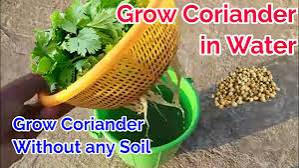How to Grow Dhania (Coriander) at Home Without Soil or Sand
Growing your own herbs at home is not only a rewarding experience but also ensures that you have fresh, organic ingredients on hand. One such herb that’s easy to grow at home is **dhania**, also known as coriander. Typically grown in soil, there are alternative methods to grow dhania without soil or sand, such as hydroponics or the use of water-based systems. These methods are clean, efficient, and convenient for those with limited space or poor soil conditions. Here’s a guide on how to grow dhania at home without soil or sand.
1. **What You Need to Get Started**
Before diving into the process, gather the following materials:
- **Coriander seeds** (dhania)
- **Containers**: You can use jars, bowls, or any container with a wide opening. These will act as your growing vessels.
- **Water**: Clean, room-temperature water.
- **Hydroponic solution or nutrients** (optional but helpful for growth).
- **A sunny spot**: Coriander thrives in plenty of sunlight, so choose a location that gets at least 4-5 hours of sunlight each day.
2. **Soak the Seeds**
Coriander seeds have a tough outer shell, which can slow down germination. Soaking the seeds for 12-24 hours before planting will help speed up the process. Place the seeds in a small bowl of water and leave them overnight. After soaking, rinse the seeds and let them drain before using them to grow.
3. **Water-Based Growing (Hydroponic Method)**
The simplest method to grow dhania without soil is using a **water-based hydroponic system**. Here’s how to do it:
- **Step 1: Prepare the Container**
Choose a container with a wide opening. You can use anything from a glass jar to a shallow dish. The key is to ensure the container can hold water while providing enough space for the plant roots to spread.
- **Step 2: Add Water**
Fill the container with clean water up to about 2-3 inches. It’s important that the seeds’ roots are submerged in water but the tops of the seeds remain exposed to air.
- Step 3: Position the Seeds
Sprinkle the soaked coriander seeds evenly over the surface of the water. If you are using a larger container, you can plant the seeds in small groups. As the seeds start to germinate, the roots will grow downward into the water.
- Step 4: Provide Nutrients (Optional)
If you want to enhance growth, consider adding a hydroponic nutrient solution to the water. This will provide essential minerals like nitrogen, potassium, and phosphorus, which are important for healthy plant growth.
- **Step 5: Place in a Sunny Spot**
Place the container in a location that receives plenty of sunlight. A south-facing window or balcony is ideal. Coriander needs at least 4-5 hours of sunlight daily to grow well.
- Step 6: Maintain the Water Level
Keep an eye on the water level in the container. Add water as needed to maintain the same depth. Ensure that the water stays clean by changing it every 2-3 days.
4. Growth and Harvesting
After about 7-10 days, you will start to see green shoots emerging from the water. These are the first signs of your coriander plants beginning to grow. Within 2-3 weeks, your dhania plants will grow tall enough to be harvested.
To harvest, use a pair of scissors to snip off the outer leaves, leaving the inner growth intact. This will allow the plant to continue producing fresh leaves. As coriander grows quickly, you can continue harvesting leaves over time as long as the plant is healthy.
5. Common Issues and Solutions
While growing coriander without soil is relatively simple, there are a few things to keep in mind:
- **Water Quality**: Make sure you are using clean, non-chlorinated water. If your tap water has a high chlorine content, let it sit for a few hours before using it to water your plants.
- **Pests and Mold**: Since you’re growing your plants in a water-based system, there’s always a risk of fungal growth or pests. Regularly inspect your plants and change the water frequently to prevent this.
- **Sunlight**: Without enough light, your coriander will grow slowly and might become leggy. Ensure they get enough light, and if necessary, supplement with a grow light if natural light is insufficient.
- Roots Rotting: If you notice the roots turning brown or slimy, it could be due to stagnant water. Regular water changes are key to preventing root rot.
6. Alternative: Growing in a Wet Paper Towel
Another easy method for growing coriander without soil is using a wet paper towel. Place the soaked seeds on a damp paper towel inside a shallow container. Keep the towel moist by spraying it with water daily. The seeds will sprout within a few days. Once the shoots are large enough, you can transfer them to a water-based system or continue to grow them in the paper towel until they're ready to harvest.
Conclusion
Growing **dhania** at home without soil or sand is a simple and efficient way to enjoy fresh coriander year-round. By using a water-based or hydroponic system, you can cultivate healthy plants with minimal space and effort. With proper care and attention, your indoor coriander garden can thrive, providing you with delicious, homegrown herbs for cooking and garnishing your meals.



